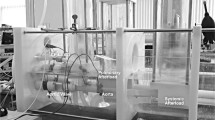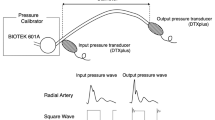Abstract
1/R control is a physiological control method of the total artificial heart (TAH) with which long-term survival was obtained with animal experiments. However, 1/R control occasionally diverged in the undulation pump TAH (UPTAH) animal experiment. To improve the control stability of the 1/R control, appropriate control time constant in relation to characteristics of the baroreflex vascular system was investigated with frequency analysis and numerical simulation. In the frequency analysis, data of five goats in which the UPTAH was implanted were analyzed with first Fourier transform technique to examine the vasomotion frequency. The numerical simulation was carried out repeatedly changing baroreflex parameters and control time constant using the elements-expanded Windkessel model. Results of the frequency analysis showed that the 1/R control tended to diverge when very low frequency band that was an indication of the vasomotion frequency was relative high. In numerical simulation, divergence of the 1/R control could be reproduced and the boundary curves between the divergence and convergence of the 1/R control varied depending on the control time constant. These results suggested that the 1/R control tended to be unstable when the TAH recipient had high reflex speed in the baroreflex vascular system. Therefore, the control time constant should be adjusted appropriately with the individual vasomotion frequency.







Similar content being viewed by others
References
Hennig E, Grosse-Siestrup C, Krautzberger W, et al. The relationship of cardiac output and venous pressure in long surviving calves with total artificial heart. Trans Am Soc Artif Intern Organs. 1978;24:616–23.
Takatani S, Harasaki H, Koike S, et al. Optimum control mode for a total artificial heart. Trans Am Soc Artif Intern Organs. 1982;28:148–53.
Vasku J. Perspectives of total artificial heart research as a valuable modelling system for general physiology and pathophysiology. In: Akutsu T, Koyanagi H, editors. Heart replacement—artificial heart 4. Tokyo: Springer-Verlag; 1998. p. 161–71.
Imachi K, Fujimasa I, Omichi H, Mano I, Nishisaka T, Iwai N, Atsumi K. Cardiac output control and blood circulation in artificial heart. Jpn J Artif Organs. 1976;5:321–7.
Pierce WS, Landis D, O’Bannon W, Donachy JH, White W, Phillips W, Brighton JA. Automatic control of artificial heart. Trans Am Soc Artif Intern Organs. 1976;22:347–56.
Abe Y, Chinzei T, Mabuchi K, Snyder AJ, Isoyama T, Imanishi K, Ymonezawa T, Matsuura H, Kouno A, Ono T, Atsumi K, Fujimasa I, Imachi K. Physiological control of a total artificial heart: conductance- and arterial pressure-based control. J Appl Physiol. 1998;84:868–76.
Abe Y, Chinzei T, Mabuchi K, Isoyama T, Baba K, Matsuura H, Kouno A, Ono T, Mochizuki S, Sun YP, Imanishi K, Atsumi K, Fujimasa I, Imachi K. Over 500 days survival of a total artificial heart goat with 1/R control. In: Akutsu T, Koyanagi H, editors. Heart replacement—artificial heart 6. Tokyo: Springer-Verlag; 1998. p. 34–40.
Abe Y, Isoyama T, Saito I, Shi W, Inoue Y, Ishii K, Nakagawa H, Ono T, Ono M, Imachi K. Results of animal experiments with the fourth model of the undulation pump total artificial heart. Artif Organs. 2011;35:781–90.
Ikeda Y, Kawada T, Sugimachi M, Kawaguchi O, Shishido T, Sato T, Miyano H, Matsuura W, Alexander J Jr, Sunagawa K. Neural arc of baroreflex optimizes dynamic pressure regulation in achieving both stability and quickness. Am J Physiol, Heart and Circ Physiol. 1996;271:882–90.
Bertram D, Barres C, Cuisinaud G, Julien C. The arterial baroreceptor reflex of the rat exhibits positive feedback properties at the frequency of Mayer waves. J Physiol. 1998;513:251–61.
Stergiopulos N, Segers P, Westerhof N. Use of pulse pressure method for estimating total arterial compliance in vivo. Am J Physiol, Heart and Circ Physiol. 1999;276:424–8.
Borst C, Karemaker JM. Time delays in the human baroreceptor reflex. J Auton Nerv Syst. 1983;9:399–409.
Gulli G, Cooper VL, Claydon VE, Hainsworth R. Prolonged latency in the baroreflex mediated vascular resistance response in subjects with postural related syncope. Clin Auton Res. 2005;15:207–12.
Acknowledgements
This study was supported in part by the JSPS KAKENHI Grant Number 26253071. We thank Mathworks, Inc for numerical analysis and simulation with MATLAB.
Author information
Authors and Affiliations
Corresponding authors
Ethics declarations
Conflict of interest
None to declare.
Rights and permissions
About this article
Cite this article
Mizuta, S., Saito, I., Isoyama, T. et al. Appropriate control time constant in relation to characteristics of the baroreflex vascular system in 1/R control of the total artificial heart. J Artif Organs 20, 200–205 (2017). https://doi.org/10.1007/s10047-017-0965-6
Received:
Accepted:
Published:
Issue Date:
DOI: https://doi.org/10.1007/s10047-017-0965-6




